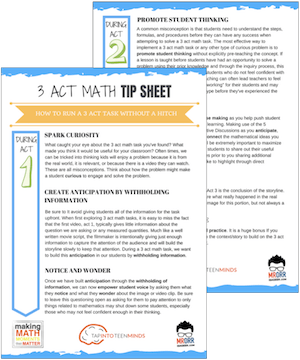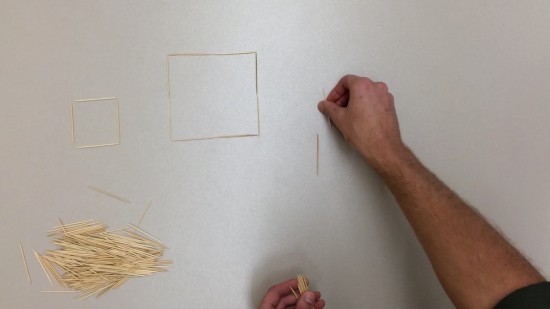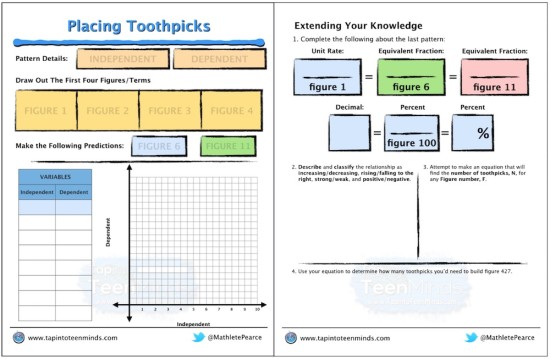Ontario Alignment By Overall Expectation
Grade 7 [Patterning and Algebra - PA1, Patterning and Algebra - PA2]
Grade 8 [Patterning and Algebra - PA1, Patterning and Algebra - PA2]
MAT1L
MAT2L
MFM1P [Linear Relations - LR1, Linear Relations - LR2, Linear Relations - LR3, Number Sense and Algebra - NA1]
MPM1D [LR2, Number Sense and Algebra - NA2]
Patterning, Proportional/Direct Variation Linear Relations
Patterning is something that comes up early in the Ontario Elementary Math Curriculum during the primary grades often connecting directly to proportional reasoning, and then evolves into direct variation linear relations in the grade 9 academic and applied courses. In both the academic and applied grade 9 courses I teach, I try to integrate proportional reasoning early and often – slowly scaffolding students towards one-step equations and the characteristics of linear relations.
Today, I’m going to share out the following 3 act math task that Justin Levack and I filmed last year keeping the grade 9 academic curriculum in mind. In particular, this task can be connected to:
- NA2.02 – I can solve problems requiring the manipulation of expressions arising from applications of percent, ratio, rate, and proportion.
- NA2.07 – I can solve first-degree equations, including equations with fractional coefficients, using a variety of tools and strategies. (minus fractional coefficients)
- LR2.02 – I can construct tables of values, scatter plots, and lines or curves of best fit as appropriate, using a variety of tools for linearly related and non-linearly related data collected from a variety of sources.
- LR2.03 – I can identify, through investigation, some properties of linear relations and apply these properties to determine whether a relation is linear or non-linear (by rate of change/initial value when described in words, by first differences in a table, straight/curved graph, degree of terms in equation).
- LR2.04 – I can compare the properties of direct variation and partial variation in applications, and identify the initial value when described in words, represented as a table, a graph, or an equation.
- …and many more!
Let’s get started!
Act 1 – What’s the Question?
Show the students the video below:
Can’t see the video? Click here.
At this point, I’d be asking my students what questions they have. You can write these questions on the board or if the kids have devices, use something collaborative like a Padlet wall:
Can’t see the padlet wall? Click here.
Act 2 – Revealing More Information
After some questions are shared out, you can show students the following video:
Can’t see the video? Click here.
The questions I want students to think about are:
How many toothpicks are in the 6th term? … the 11th term?
I would likely have students figure this out on their own, using any strategy and then consolidate the task. The following math task template might be a good option to consolidate student thinking:
Act 3 – Reveal the Solutions
You can now let students see their solution in action!
Act 3, Scene 1 – Figure 6 Solution
Can’t see the video? Click here.
Act 3, Scene 2 – Figure 11 Solution
Can’t see the video? Click here.
Have you tried this task? How can we make it better? Share your thoughts in the comments below!
New to Using 3 Act Math Tasks?
Download the 2-page printable 3 Act Math Tip Sheet to ensure that you have the best start to your journey using 3 Act math Tasks to spark curiosity and fuel sense making in your math classroom!

Share With Your Learning Community:

About Kyle Pearce
I’m Kyle Pearce and I am a former high school math teacher. I’m now the K-12 Mathematics Consultant with the Greater Essex County District School Board, where I uncover creative ways to spark curiosity and fuel sense making in mathematics. Read more.
Access Other Real World Math Tasks
Search More 3 Act Math Tasks
Grade 2 [2.B1.1, 2.B1.3, 2.B2.1, 2.B2.2, 2.B2.3, 2.B2.4, Measurement - M1, Number Sense and Numeration - NS1, Number Sense and Numeration - NS2, Number Sense and Numeration - NS3]
Grade 3 [3.B1.5, 3.B2.1, 3.B2.3, 3.B2.7, Measurement - M1, Number Sense and Numeration - NS1, Number Sense and Numeration - NS3]
Grade 4 [4.B2.1, 4.B2.4, 4.E2.5, 4.E2.6, Measurement - M1, Number Sense and Numeration - NS1, Number Sense and Numeration - NS3, Patterning and Algebra - PA2]
Grade 5 [5.B1.7, 5.B2.9, 5.D1.3, 5.D1.6, 5.E2.6, 5.F1.2, 5.F1.5, Measurement - M1, Measurement - M2, Number Sense and Numeration - NS1, Number Sense and Numeration - NS3, Patterning and Algebra - PA2]
Grade 6 [6.B2.12, 6.B2.9, Data Management and Probability - DP3, Measurement - M1, Measurement - M2, Number Sense and Numeration - NS1, Number Sense and Numeration - NS2, Number Sense and Numeration - NS3, Patterning and Algebra - PA1, Patterning and Algebra - PA2]
Grade 7 [7.B1.3, 7.B1.4, 7.B1.7, 7.B2.2, 7.B2.3, 7.C1.1, 7.C1.2, 7.C1.3, 7.C1.4, 7.D1.6, Data Management and Probability - DP3, Geometry and Spatial Sense - GS1, Measurement - M1, Measurement - M2, Number Sense and Numeration - NS1, Number Sense and Numeration - NS2, Number Sense and Numeration - NS3, Patterning and Algebra - PA1, Patterning and Algebra - PA2]
Grade 8 [8.B1.4, 8.B2.5, 8.C1.1, 8.C1.2, 8.C1.3, 8.C1.4, Data Management and Probability - DP1, Data Management and Probability - DP3, Geometry and Spatial Sense - GS2, Measurement - M1, Measurement - M2, Number Sense and Numeration - NS1, Number Sense and Numeration - NS2, Number Sense and Numeration - NS3, Patterning and Algebra - PA1, Patterning and Algebra - PA2]
Grade 9 [9.B3.5, 9.C3.1, 9.C3.2, 9.C3.3]
Kindergarten [k.15.1, k.15.10, k.15.2]
MAP4C [Mathematical Models - MM1, Mathematical Models - MM2, Mathematical Models - MM3]
MAT1LMAT2LMBF3C [Data Management - DM1, Data Management - DM2, Geometry and Trigonometry - GT1, Geometry and Trigonometry - GT2, Mathematical Models - MM1, Mathematical Models - MM2, Mathematical Models - MM3]
MCF3M [Exponential Functions - EF2, Quadratic Functions - QF1, Quadratic Functions - QF2, Quadratic Functions - QF3, Trigonometric Functions - TF1, Trigonometric Functions - TF3]
MCR3U [Characteristics of Functions - CF1, Characteristics of Functions - CF2, Exponential Functions - EF2, Exponential Functions - EF3, Trigonometric Functions - TF3]
MCT4C [Exponential Functions - EF1, Trigonometric Functions - TF3]
MCV4U [Derivatives and Their Applications - DA2]
MDM4U [Counting and Probability - CP2, Organization of Data For Analysis - DA2, Probability Distributions - PD1, Statistical Analysis - SA1, Statistical Analysis - SA2]
MEL4EMFM1P [Linear Relations - LR1, Linear Relations - LR2, Linear Relations - LR3, Linear Relations - LR4, Measurement and Geometry - MG1, Measurement and Geometry - MG2, Measurement and Geometry - MG3, Number Sense and Algebra - NA1, Number Sense and Algebra - NA2]
MFM2P [Measurement and Trigonometry - MT1, Measurement and Trigonometry - MT2, Measurement and Trigonometry - MT3, Modelling Linear Relations - LR1, Modelling Linear Relations - LR2, Modelling Linear Relations - LR3, Quadratic Relations in y = ax^2 + bx + c Form - QR1, Quadratic Relations in y = ax^2 + bx + c Form - QR2, Quadratic Relations in y = ax^2 + bx + c Form - QR3]
MHF4U [Characteristics of Functions - CF3, Exponential and Logarithmic Functions - EL2, Exponential and Logarithmic Functions - EL3]
MPM1D [AG3, Analytic Geometry - AG1, Analytic Geometry - AG2, LR1, LR2, LR3, MG1, MG2, MG3, NA1, Number Sense and Algebra - NA2]
MPM2D [AG1, AG2, AG3, QR2, Quadratic Relations - QR3, Quadratic Relations - QR4, T2, T3]
Functions [F-BF.1, F-BF.3, F-IF.4, F-LE.1, F-LE.2, F-LE.3, F-TF.5]
Geometry [G-C.5, G-C.8, G-C.9, G-GMD.3, G-GMD.4, G-GPE.4, G-GPE.5, G-GPE.7, G-MG.1, G-MG.2, G-SRT.11]
Grade 1 [1.NBT.4, 1.OA.1, 1.OA.6, 1.OA.A.1, 1.OA.B.3, 1.OA.B.4, 1.OA.C.5, 1.OA.C.6]
Grade 2 [2.NBT.5, 2.NBT.B.5, 2.NBT.B.8, 2.NBT.B.9, 2.OA.2, 2.OA.A.1, 2.OA.B.2]
Grade 3 [3.MD.C.5, 3.NBT.2, 3.NF.1, 3.NF.2, 3.NF.3, 3.NF.A.1, 3.OA.1, 3.OA.5, 3.OA.9]
Grade 4 [4-MD.3, 4.MD.1, 4.MD.2, 4.NBT.6, 4.NF.3, 4.NF.5, 4.NF.6, 4.OA.1, 4.OA.5]
Grade 5 [5.B1.7, 5.D1.3, 5.D1.6, 5.MD.1, 5.MD.3, 5.MD.4, 5.MD.5, 5.NBT.2, 5.NBT.3, 5.NBT.6, 5.NBT.7, 5.NF.1, 5.NF.2, 5.NF.3, 5.NF.4, 5.NF.5, 5.OA.1, 5.OA.2, 5.OA.3]
Grade 6 [6.EE.1, 6.EE.2, 6.EE.5, 6.EE.6, 6.EE.7, 6.G.1, 6.G.2, 6.NS.1, 6.NS.3, 6.NS.6, 6.NS.B.3, 6.NS.C.6, 6.NS.C.7, 6.NS.C.8, 6.RP.1, 6.RP.2, 6.RP.3, 6.RP.A.1, 6.RP.A.2, 6.RP.A.3, 6.RP.A.3.C]
Grade 7 [7.EE.3, 7.EE.4, 7.EE.A.1, 7.G.3, 7.G.4, 7.G.6, 7.NS.A.1, 7.NS.A.2, 7.RP.1, 7.RP.3, 7.RP.A.2.B, 7.RP.A.3, 7.SP.2, 7.SP.5, 7.SP.6]
Grade 8 [8.EE.1, 8.EE.5, 8.EE.6, 8.EE.7, 8.EE.8, 8.F.2, 8.F.3, 8.F.4, 8.F.5, 8.G.5, 8.G.6, 8.G.7, 8.G.9, 8.SP.1]
Grade 9Kindergarten [K.CC.A.1, K.NBT.A.1, K.OA.A.1, K.OA.A.2, K.OA.A.3]
Practice [MP.1, MP.2, MP.3, MP.4, MP.6, MP.7]
Statistics & Probability [S-ID.6, S-MD.4]



I want to try this next year. I have never done 3 act math. Wish me luck.
Awesome! Give it a go! Heck, might be a good way to get into reviewing course material as the end of the school year comes up. Let me know if I can help!
Thanks Kyle, Do you have notes or some littérature on how to do a 3 act math lesson?
2016-05-09 10:03 GMT-04:00 Disqus :
Hi Lynn,
I just recently posted a blog about what a 3 act task is and why they are useful here:
https://tapintoteenminds.com/what-makes-3-act-math-tasks-so-effective/
However, the original creator of the idea is Dan Meyer. His post is a must read:
http://blog.mrmeyer.com/2011/the-three-acts-of-a-mathematical-story/
Let me know how it goes!
Kyle and Justin,
Thanks for sharing this 3 Act Task. How much time in total do you think this takes? I’m planning on doing at least one 3 Act Task a week this school year as a warm up, but also want to make sure we can get in the grove of not taking up too much class time. Thanks for any information you’d be able to provide!
Hi Scott,
So happy to hear you’re looking forward to using this task and maybe some other 3 act tasks!
Firstly, I’d nudge you to consider using 3 act tasks as the “guts” of your problem based lesson rather than a “warm-up”. They aren’t an “add on” to a direct instruction lesson, but rather as a means to spark curiosity and help to lead to fuel sense making in students through reasoning…
As for time – it always depends on the learners… grade level… student readiness… etc. but I tend to try to make a task the core of the lesson then build some of the big ideas via consolidation.
Check out makemathmoments.com/framework for more details on this…
Hope this helps!
A darker background would help the toothpicks stand out.
Hi Greg – so true. I’m a *little* better now at planning that sort of thing. May need to go back and reshoot at some point 🙂
Can I get access to the worksheet?